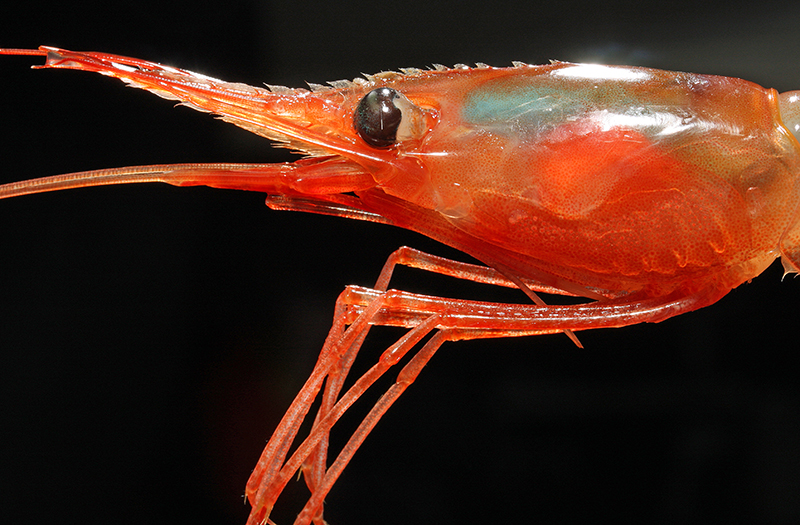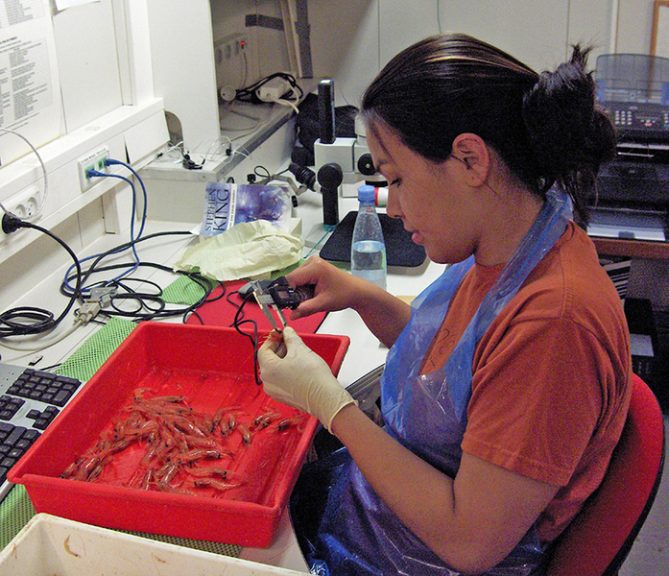Shrimps
The deep-sea shrimp, Pandalus borealis, occurs in its southern range on the continental shelf in the North Sea and Skagerak and in the Gulf of Maine on the east coast of the United States. In the northern area, it is found in the Barents Sea north of Norway, around Iceland and in the Strait of Denmark and the Strait of Davis near Greenland. The deep-sea shrimp also live in the northern Pacific Ocean off Alaska and in northern Japan.
The work with shrimp in the Greenland Institute of Natural Resources is concentrated on the following main tasks:
- Biological studies in West Greenland (approx. 2½ months each summer)
- Creation and processing of data from logbooks (continuously throughout the year)
- Measurement of shrimp samples from the fishery (continuous throughout the year)
- Preparation of the biological advice
- Training of fisheries inspectors so that in future they can measure shrimp from the fishery directly on board the trawlers
- Reassessment of the methods used for biological studies
- Analysis of previously collected data to gain increased knowledge about the relationship between shrimp size and age
- Study of a local shrimp stock to gain increased knowledge about the shrimp’s annual cycle
- Examination of the recruitment process
- Development of a mathematical model that can describe and predict how the stock develops.
The biology of the deep-sea shrimp

A female pandalus borealis.
The deep-sea shrimp, Pandalus borealis, is a “first-hand hermaphrodite”. That is, during a lifetime, a shrimp is both he and she (= hermaphrodite), and it begins its adult life as he.
The shrimp starts its life cycle as an egg that develops just below the female’s main shield (the blue-green spot behind the eye of the live shrimp in the picture is 1000-1500 eggs in development). The female spawns the eggs by forcing them out through two channels between the bones of the forebody, where they are fertilized with sperm, which one he has deposited. The fertilized eggs are held between the swimming legs under the female’s hind body until they hatch eight months later. The newly hatched larvae live freely in the upper part of the water and undergo several different larval stages before reaching a size where they search down towards the bottom.
When the shrimp is approx. 4 years old, it is fully grown and acts like a sexually mature male. It does this for 2-3 years, and during that time it can mate several times. When the shrimp is 6-7 years old and weighs 7-9 grams, it changes sex and now lives the rest of its life like she does. An old female can weigh up to approx. 25 grams.
Deep-sea prawns are most common at depths from approx. 50 to 600 meters and most often on muddy bottoms (they occur at far more than 1000 meters depth). They stay at varying depths throughout the day, but usually seek out the water in the evening and return to the bottom in the morning. Shrimp feed on very different foods – including worms, dead organic material, algae and various small animals – and are themselves food for larger fish such as cod, halibut, halibut and salmon.
Biological studies

Since the end of the 1940s, the Greenland Fisheries Research Institute / Greenland Institute of Natural Resources has conducted studies of shrimp. Initially, surveys took place exclusively in the coastal areas and in Disko Bay, but from the end of the 1960s, they also began to study the offshore part of the stock. The work initially consisted mainly of finding new shrimp deposits and assessing whether they were large enough to be exploited commercially. It was not until the 1970s that biologists began advising on how much could be caught if fishing were to be sustainable. Since 1988, the institute has every year from the beginning of July to the middle of September examined the stock of shrimp in West Greenland.
The department’s trawler fishes approx. 250 different places (stations) evenly distributed along the entire west coast – both in areas with many and with few shrimps. They also fish at different depths from 150 meters to 600 meters depth. In this way, we get to examine the entire area where shrimp live, and not just the areas where most and largest shrimp are. We also get a measure of how many shrimps there are in the stock. The catch from each trawl trailer is examined in the same way every single time. We sort the whole catch – shrimp separately and fish species separately. The amount of each species is weighed to determine how large a part of the catch it constitutes. In addition, we examine some of the fish species in more detail – including halibut and redfish. The results from this are used by the biologists working with the species in question. We take a small sample from the shrimp catch, which is examined in more detail. First, the shrimp are sorted into species. The deep-sea shrimp (Pandalus borealis), which is the most important species for fishing, is sorted into different stages of development – e.g., females with head eggs, females with bone eggs, males, transitional animals, and individuals with parasites. Finally, the shield length of each shrimp is measured with a caliper. The information gathered tells us something about how the stock of shrimp is doing. E.g., about how many young shrimps are in the stock, whether there are enough females to carry the species forward
Data from the fishery
The data from the fishery that the biologists at the Greenland Institute of Natural Resources use come both from the ships’ logbooks, from the catch itself and from the procurement.
Logbook obligation since 1996
Since December 1996, all trawlers have been obliged to keep a logbook of their catches and submit the information to the Greenland Fisheries License Control – GLFK. The logbooks contain i.a. information on where the fishing took place, the size of the catch and any by-catch. The biologists use information from the logbooks, among other things. to assess how much effort is required to catch a certain amount of shrimp, i.e.. how long it takes to haul before the trawl is hauled in and whether the fishing is concentrated in certain areas. That information compares biologists with logbook information from previous years to assess any differences and trends.
Biological advice – how?
All the information collected from the biological studies and from the fishery is processed and analyzed at the Greenland Institute of Natural Resources. Our results are then presented and discussed in the international fisheries organization NAFO, which ultimately prepares the biological advice to the Government of Greenland. In NAFO, biologists from different countries (including Canada, Iceland and Greenland) meet and compare and evaluate all information presented. The biologists then prepare a comprehensive biological advice for the deep-sea shrimp stock, and this advice is then assessed once again by NAFO’s Scientific Council before it is handed over to the Government of Greenland.
The results and assessments we arrive at at the Institute are thus “inspected” several times before they are handed over to the Government.
Fishing historically
In the late 1940s, the Greenland Fisheries Survey conducted the first actual surveys for shrimp on the west coast, and the important inland deposits were found. Around 1950, the Greenlandic fishery for shrimp started as an inland fishery in Disko Bay. The fishing took place with smaller cutters and gained importance for several cities and issuers who avoided closure. Instead, shrimp factories were built in Qasigiannguit, Ilulissat and later Qeqertarsuaq, and the population grew.
It was well known that there were also prawns offshore, but here there was a large fishing for cod, and therefore there was not much interest in the prawns. In the mid-1960s, catches of cod fishery declined and interest in shrimp increased. At the same time, the Greenland Fisheries Survey started surveys of the offshore stocks, and it quickly became clear that there were good opportunities for fishing. The results of the surveys were not published immediately at the request of KGH (The Royal Greenland Trade). The Greenlandic cutter fleet was not suitable for offshore fishing, and KGH was afraid that foreign ships would start a large fishery. The results of the surveys were published in 1969 at the same time as Faroese trawlers began fishing for shrimp offshore.
In 1975, the first KGH trawler was put into the shrimp fishery.

